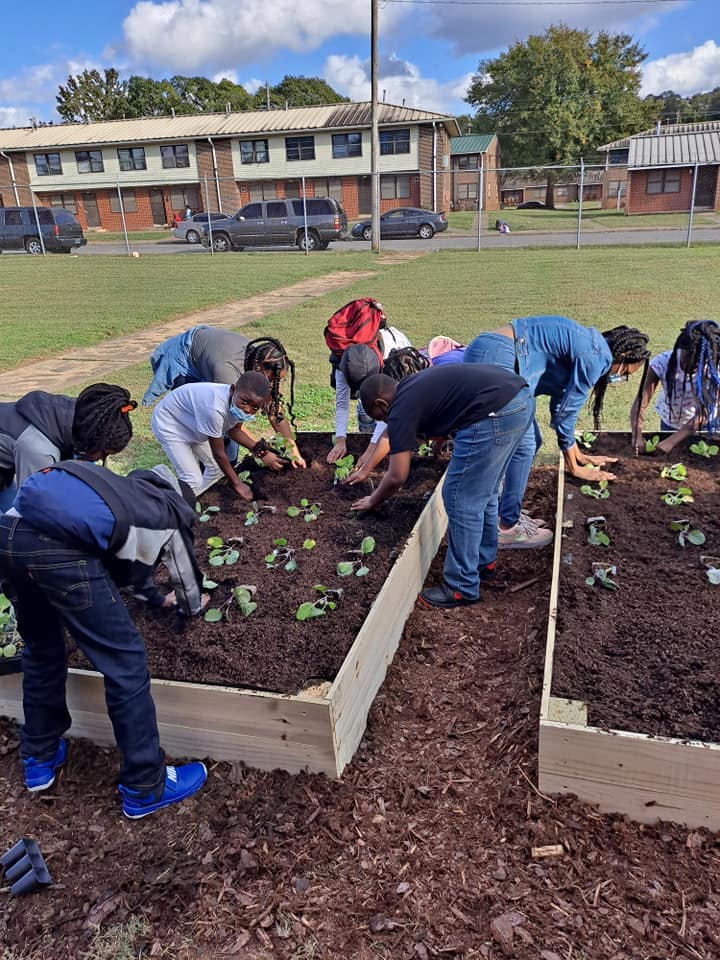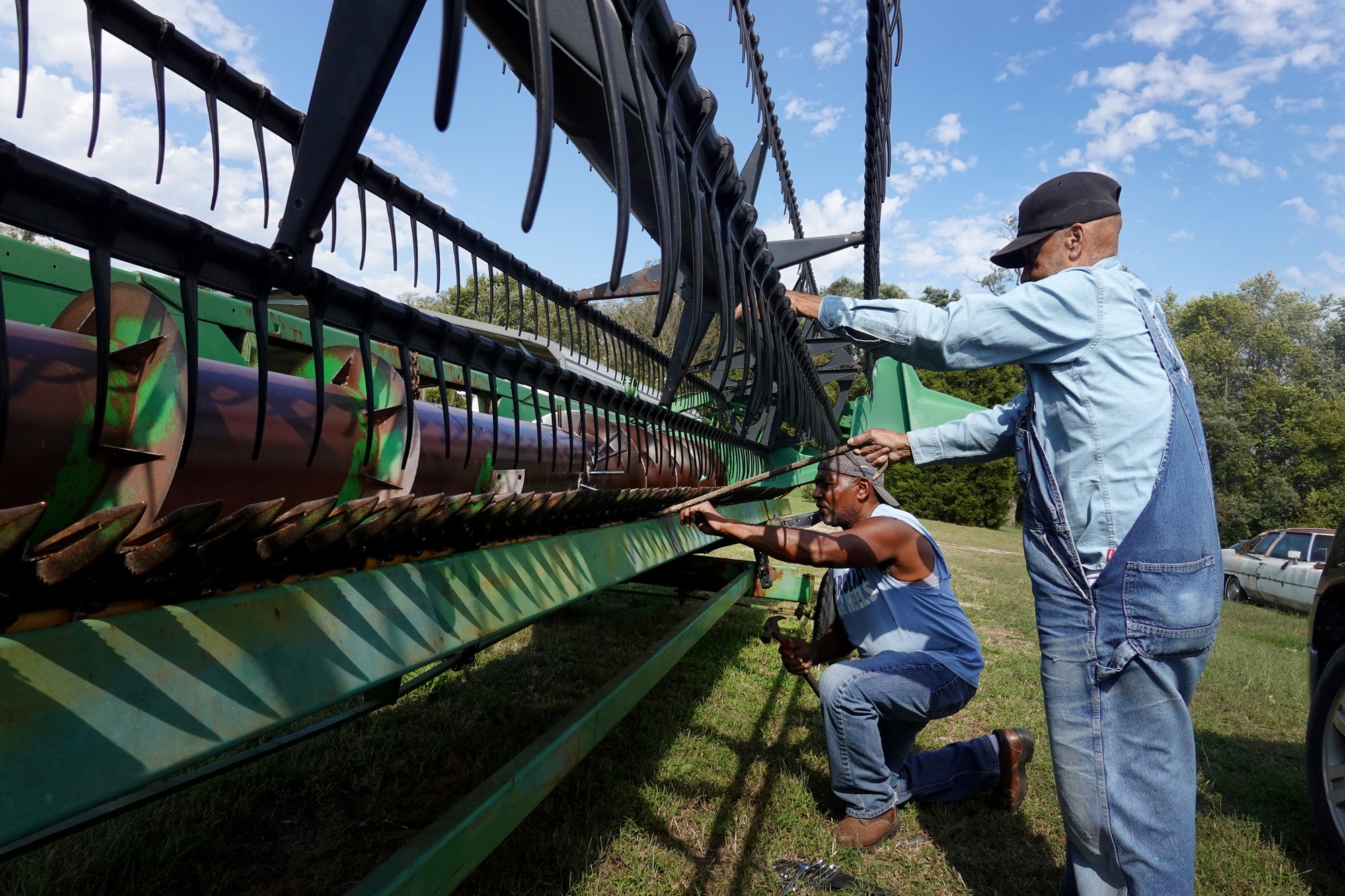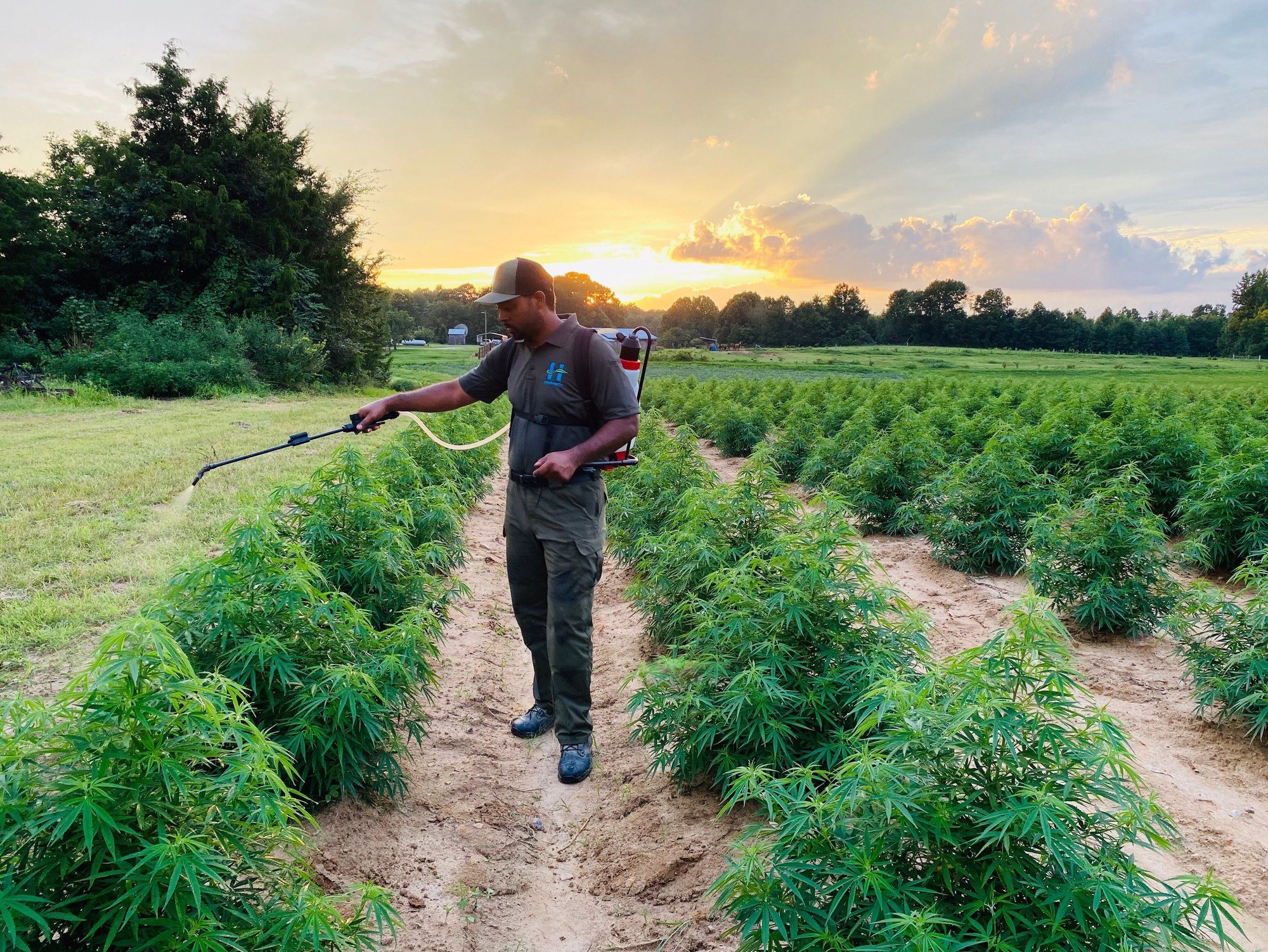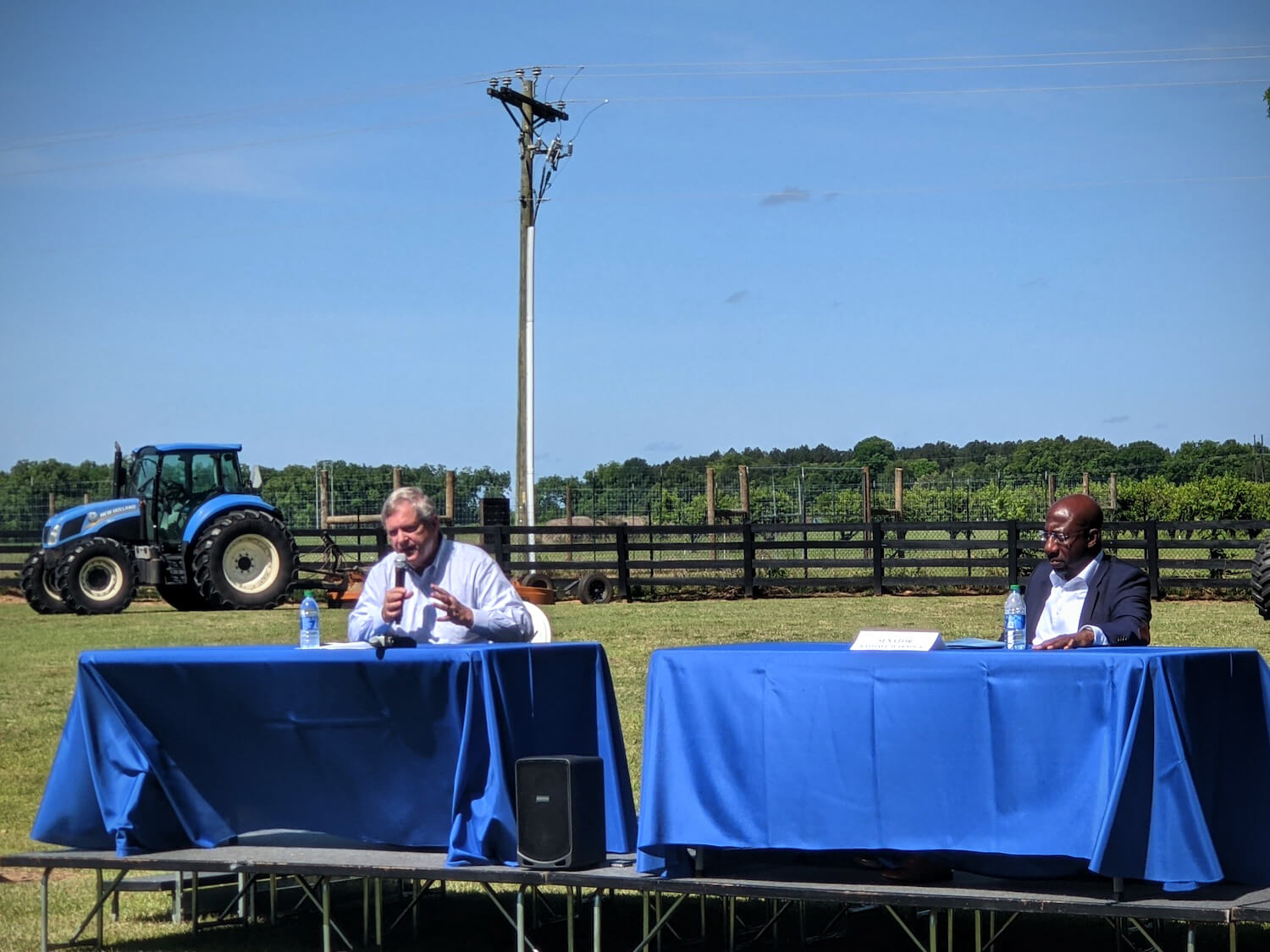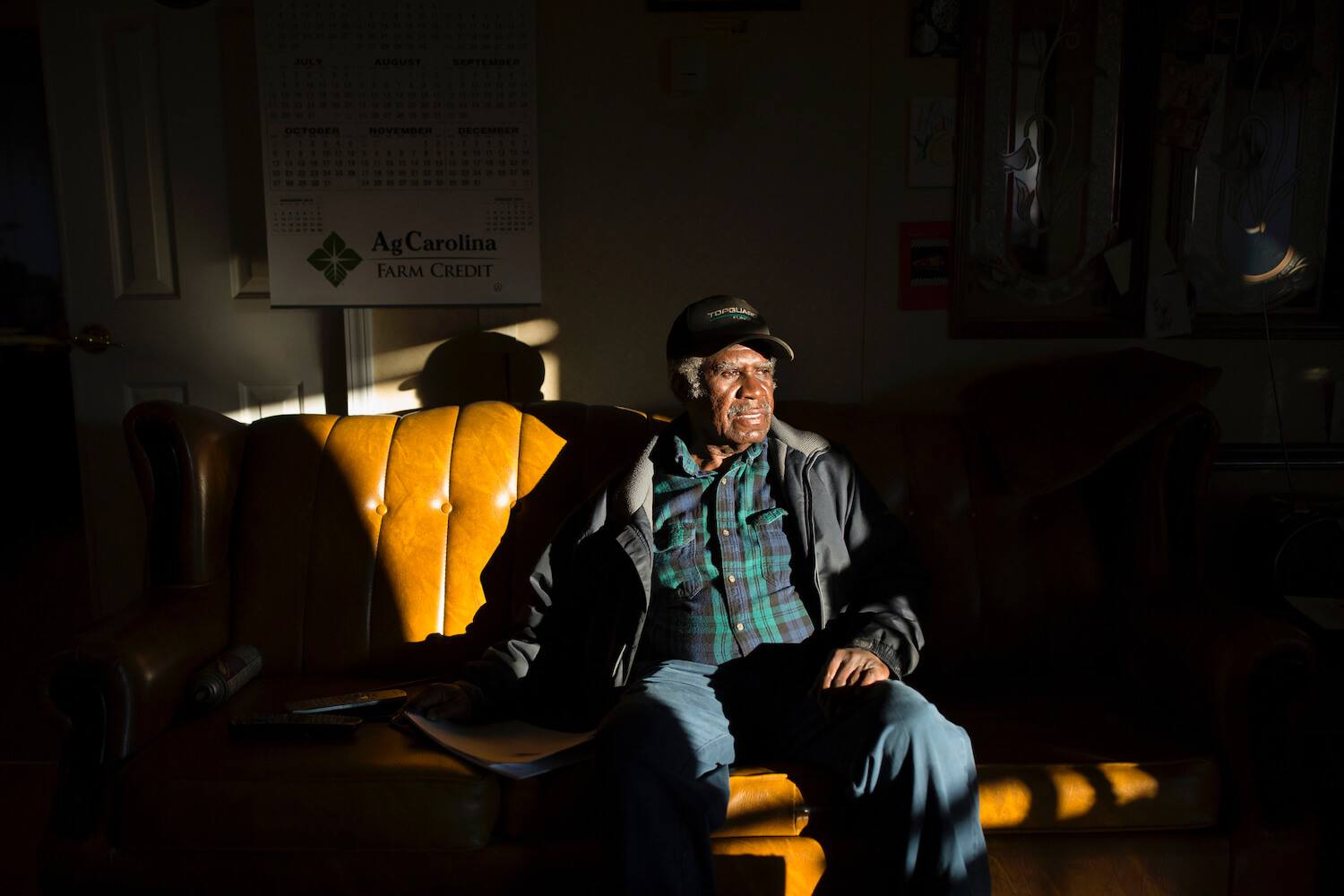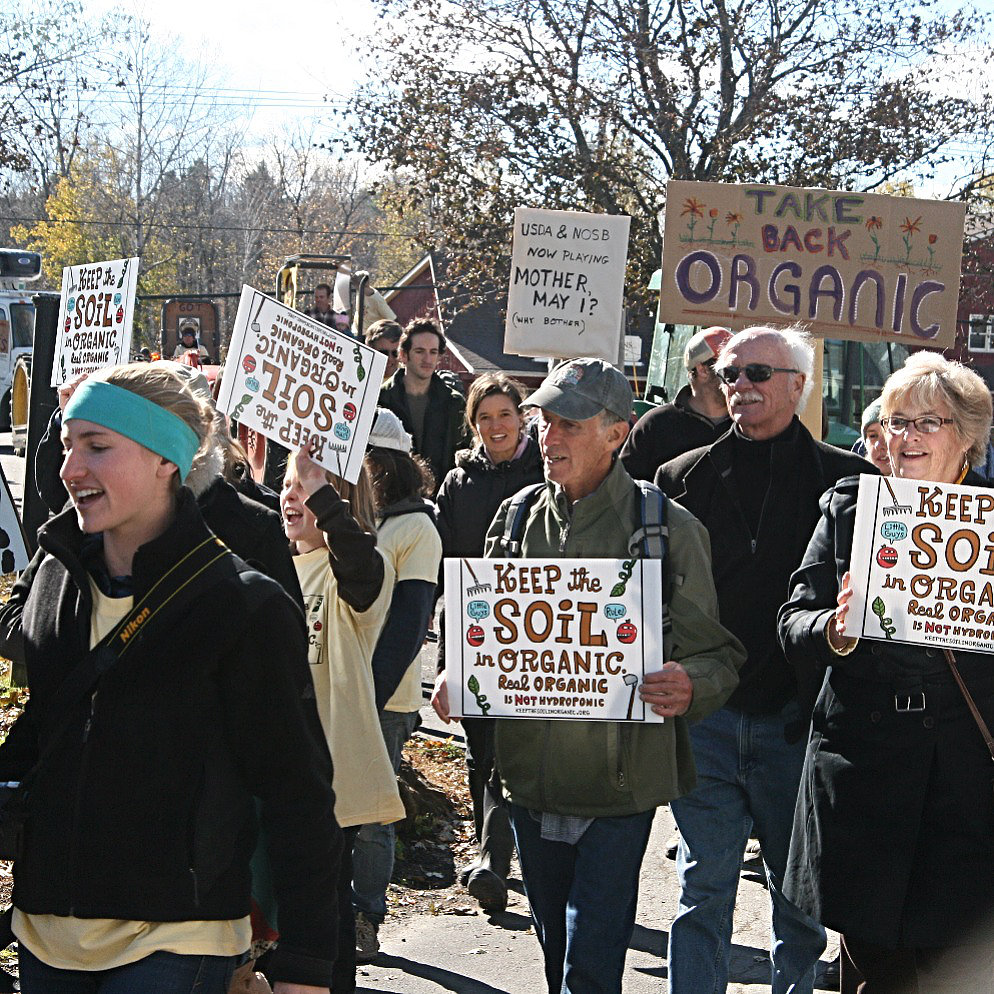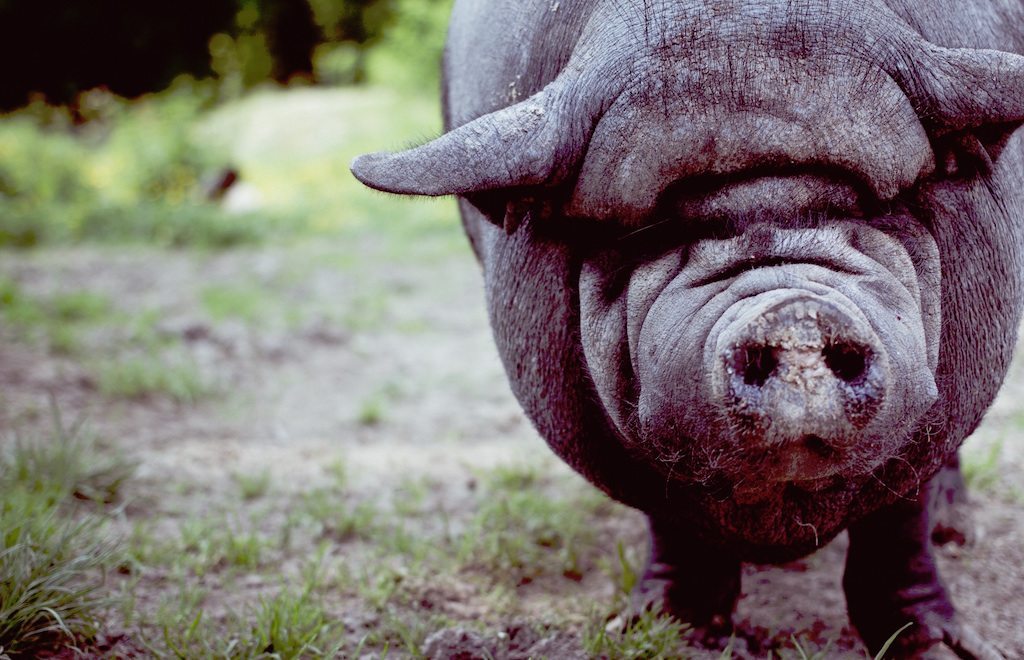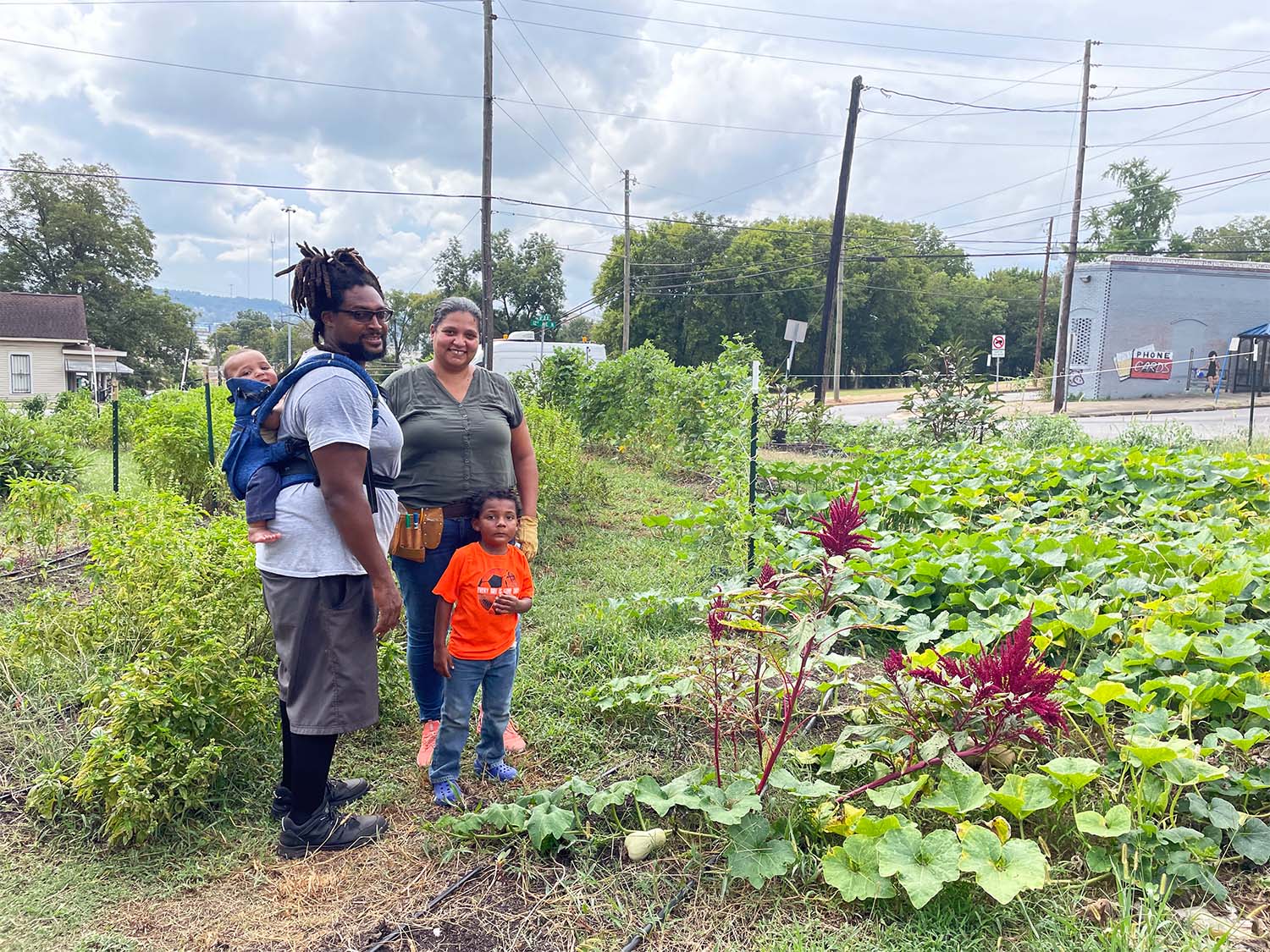
Safiya Charles
With few accredited training programs, some urban farmers have developed their own methods of learning and farmer-to-farmer networks to explore whether aquaponics can benefit their communities.
Pictured above: Chris Gooden (left) and Dominique Villanueva with two of their children on their half-acre urban farm in Birmingham, Alabama.
On a sunny September day, Dominique Villanueva and Chris Gooden began digging a 4-by-16 foot pit next to their Birmingham, Alabama, home. Gooden grasped a pick ax and lashed the ground to loosen the dense mixture of soil, rock, clay, and brick—remnants of a decades-old demolished house that once stood on the vacant plot. Taking a shovel, he heaved dirt outside the pit to smooth and gradually deepen the impression.
Villanueva, toting their 9-month-old baby on her back and with their 3-year-old trailing behind her, piled the excess dirt into a wheelbarrow and steered it toward the back of the greenhouse where she dumped the load. Over the course of a week, the couple dug four more pits, earthen grow beds outfitted with wood panels and lined in plastic.
Ricky Davis, a farmer in the nearby suburb of Bessemer, said it took him two years to convince the couple that they could start raising tilapia using aquaponics at Fountain Heights Farm, a produce farm they founded just a few miles from Birmingham’s city center in 2017.
Aquaponics combines hydroponics—growing plants in water without soil—and aquaculture—farming fish in a controlled environment. Over the last 50 years or so, this ancient method—once practiced by the Aztecs and throughout Asia—has grown from the pursuit of a few scientific researchers and backyard hobbyists to a subject that increasingly appears in university-led workshops, short-term courses, and bills in the U.S. Senate.
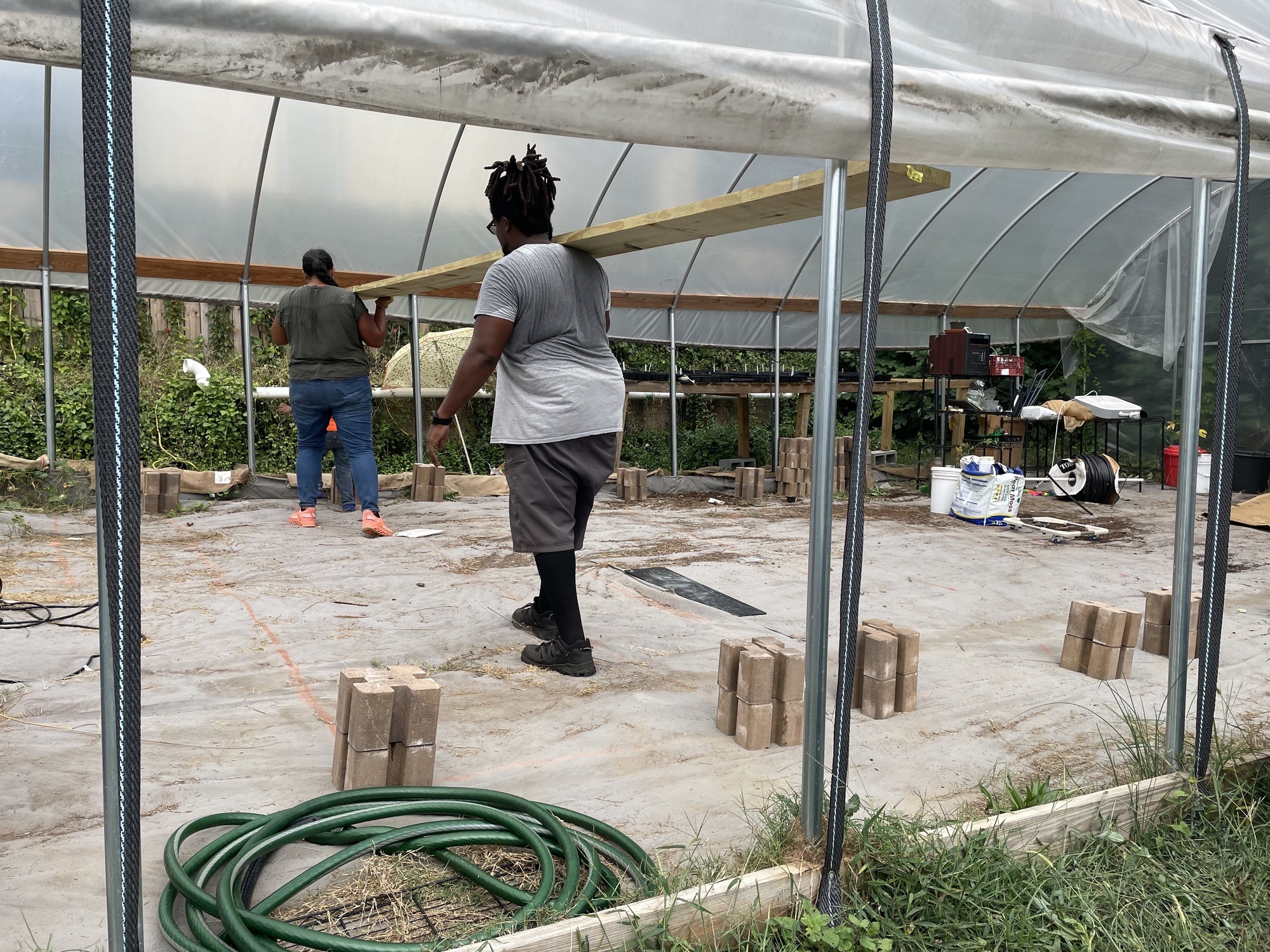
Villanueva and Gooden began to plan their urban farm in 2017 and decided to incorporate aquaponics as a way to grow more efficiently.
Safiya Charles
But despite the heightened interest in the method, many of the new courses lack scientific rigor and can run hundreds, if not thousands, of dollars; few accredited semester-length university courses or degree programs exist. So many aquaponics growers still rely on self-teaching, learning from each other in real life, and “YouTube University” or social media platforms.
“At the end of 2019, we surveyed just under 400 aquaponics producers, and the number one thing that people wanted was to talk to other farmers,” said Janelle Hager, aquaponics state specialist at Kentucky State University. “There is a discrepancy there because a lot of the growth in aquaponics early on started with backyard systems. So you have a lot of people on YouTube, you have a lot of people selling a lot of stuff. There’s just so much information that it’s really difficult to wade through all of that and find credible, replicated research that’s [provided] in a way that the public can understand and use it. I think [making that information more accessible] is what universities are doing in that regard right now.”
However, Fountain Heights’ effort is one of a growing number of aquaponics initiatives by Black farmers outside university programs in urban Alabama. They’re taking root through collaborative action, growing a network that’s learning from each other, and building systems that they hope can literally feed communities. Through their attempts to expand access to healthy produce and strengthen Black people’s ties to agriculture, these farmers have developed meaningful connections and shared information among like-minded urban agriculturalists and community members.
“Our neighborhood is a poor neighborhood. It’s been under-resourced. It’s been divested from. But it doesn’t mean that we don’t deserve things that are beautiful, things that are maintained, things that are owned by people in the community.”
After Villanueva and Gooden connected with Davis, a self-taught aquaponics farmer and the owner of the agricultural company Sowing Seeds, via social media in 2015, the couple began assisting him with weeding and seeding on his Bessemer farm—a backyard greenhouse he built with two tanks totaling 2,400 gallons, stocked with 200 fish. Davis taught himself the method through months of diligent research, scouring the internet for how-to-videos, and trial and error.
“We don’t have enough people of color involved in the world of agriculture. So, whenever I hear anybody of color trying to be more involved with agriculture, I feel like it’s my duty to assist,” said Davis.
When Villanueva and Gooden began to plan for their urban farm in 2017, Davis visited Fountain Heights to evaluate their setup and suggested some tweaks. He visited again when Villanueva was pregnant with the couple’s third child and helped them put finishing touches on their greenhouse. Gooden returned the favor by helping Davis repair his greenhouse after a bout of bad weather blew the plastic off.
Bit by bit, Davis began teaching them about aquaponics: how a system works, the benefits of certain fish, the importance of nutrients derived from their waste.
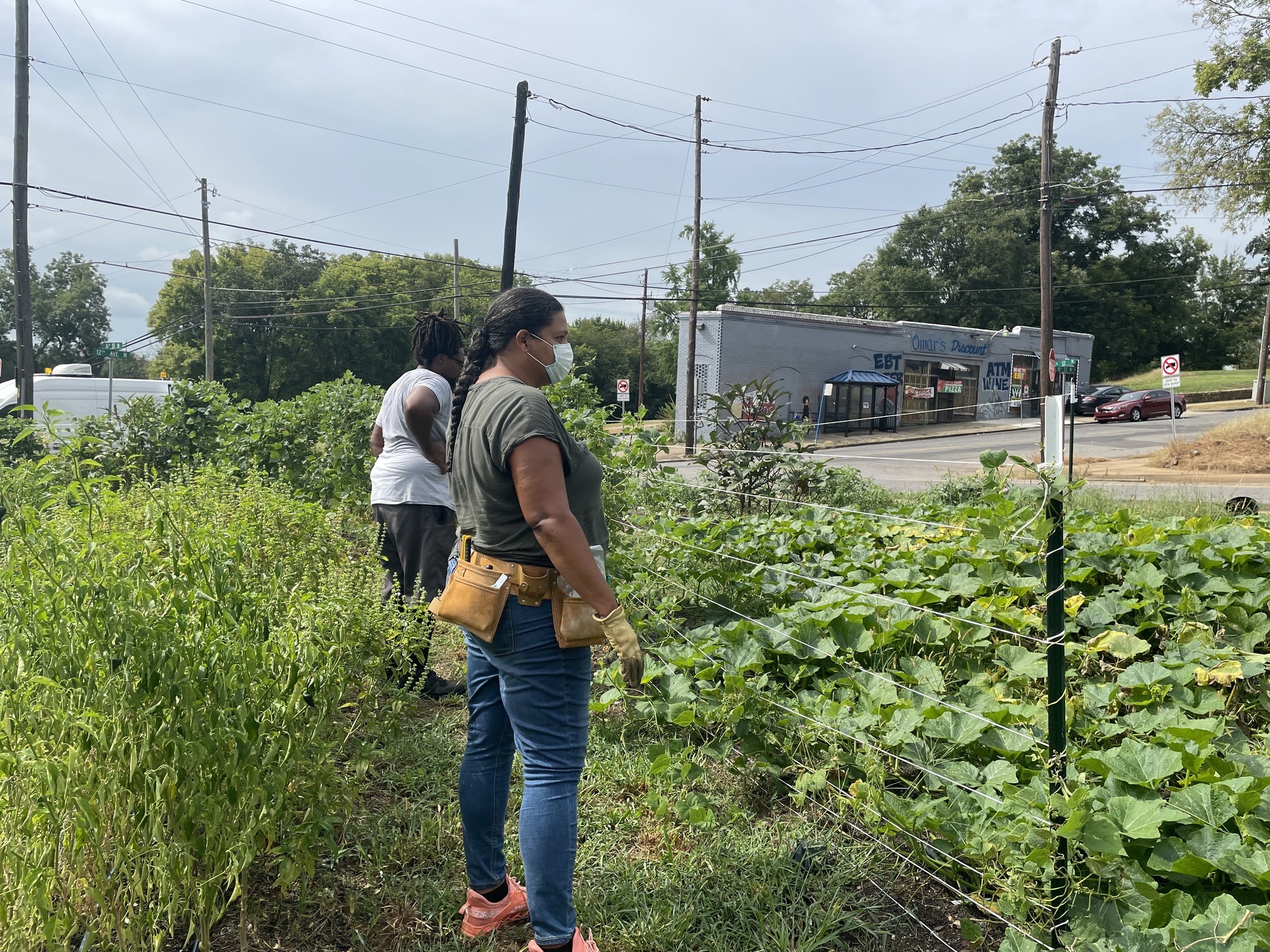
Gooden and Villanueva’s farm is a source of fresh produce distributed via a sliding-scale CSA service and a food pantry where passersby can pick up free vegetables.
Safiya Charles
To Gooden and Villanueva, aquaponics offers a way to grow more efficiently. That’s especially important on their small half-acre farm, which occupies a once-overgrown lot. Villanueva, a former teacher, and Gooden, a landscaper, asked the elderly property owner if they could cultivate it. They have turned it into an expanse that was aflutter with butterflies and bursting with greenery in late summer, where their children disappear into leafy vines and triumphantly pull out a Tahitian melon squash whose growth they’ve been watching.
The farm is also a source of fresh produce distributed via a sliding-scale CSA service and a food pantry where passersby can pick up free vegetables, no questions asked.
Like many urban farmers, the pair has tried to find an innovative solution to sustain their community and combat the socioeconomic barriers that limit its potential.
“Our neighborhood is a poor neighborhood. It’s been under-resourced. It’s been divested from. But it doesn’t mean that we don’t deserve things that are beautiful, things that are maintained, things that are owned by people in the community,” said Villanueva. “I want to see kids running through flowers and picking stuff, eating fresh tomatoes or beans. We need that kind of joy. That’s what this space is.”
They see promise in Fountain Heights, where others may only see problems. In the early to mid-20th century, the neighborhood transitioned from being a white, largely Jewish neighborhood to a desirable housing location for Birmingham’s Black middle class. That demographic change brought more social change. The area became the site of racially motivated bombings, including the well-known bombing of 16th Street Baptist Church in 1963. But as many residents moved to suburbs—and an interstate highway divided the neighborhood—Fountain Heights became a community of declining homeownership, empty homes seized by local government due to unpaid taxes, and fewer businesses. Across the street from the couple’s home is a corner convenience store, and although the nearest full-service grocer is only about 1.5 miles away, the costs of goods and distance still make traveling for groceries prohibitive for elderly and low-income earning residents.
Farming above ground is particularly important in Birmingham because decades of steel and iron manufacturing have had a marked effect on the soil of surrounding neighborhoods.
“There’s never going to be a grocery store that comes in and says, ‘Yeah, let me build [near] a Superfund site.’ There’s never going to be a lot of economic development projects in that area. So what do we do for ourselves? Because we need to eat. … So what does it look like to farm above ground?” said Villanueva.
Farming above ground is particularly important in Birmingham because decades of steel and iron manufacturing have had a marked effect on the soil of surrounding neighborhoods. North Birmingham’s 35th Avenue Superfund site, where coking and other industries contaminated swaths of the city’s soil, sits less than 4 miles north of the neighborhood. Arsenic and lead from historic, century-old homes demolished in recent years have also posed a concern. After testing their soil for contamination, Gooden and Villanueva’s property was clear, but tests on the overgrown plot that sits kitty-corner to their farm returned high levels of arsenic. And while parts of the neighborhood don’t show signs of potentially dangerous environmental residue, reports of contamination in the general area typically don’t encourage wary developers or newcomers to locate businesses or homes there.
In a few weeks, Fountain Heights Farm will fill one deep-water tank with tilapia. The fish will produce ammonia-rich waste that flows through a filtration system and into four beds arranged like a “floating raft” of greenhouse-grown plants such as strawberries and collard greens. Bacteria will help convert the ammonia to nitrates that the plants absorb through their roots. In this process, the plants remove excess nutrients and purify the water that’s sent back through another pipe into the fish tank, and the cycle repeats. When the tilapia grow to more than a pound in weight, Villanueva and Gooden hope to provide the neighborhood with a local fish source.
They learned by watching Davis, who built his first system in the fall of 2015 out of curiosity. Davis made a miniature model of his aquaponics operation out of a shoe box and cardboard; collected recycled materials such as old plastic sheeting and PVC piping; and constructed his own lumber reservoir tank to keep costs down. While Auburn University, located in central Alabama, once offered an annual three-day commercial aquaponics workshop, in addition to extension services, the campus is more than two hours south of Bessemer. The workshop, last offered in 2019, cost between $1,000-$1,200. His online education was free, but building his 16-by-36 foot greenhouse and aquaponics system for tilapia and goldfish cost Davis about $6,000. Inside the greenhouse, he runs fans to moderate the temperature and LED grow lights powered by his city utility connection.
“In my opinion, natural resources are something that city folks take for granted. Bugs are a natural resource, fish are a natural resource, the sun, plants, grass, soil. Without us turning back to farming, I think that we will never gain the economic stronghold that we need.”
Davis, who partners with three local elementary schools to host farm field days and in-school learning programs, says he’s ready to construct a larger greenhouse that can facilitate more efficient growing space and educational tours. K-12 school programs have offered sustained interest in aquaponics in recent years because they provide educators visual and hands-on, activity-based projects that can boost students’ interest in careers in STEM (science, technology, engineering, and mathematics).
“My whole thing is I want to get [Black people and people of color] involved in agriculture. … In my opinion, natural resources are something that city folks take for granted. Bugs are a natural resource, fish are a natural resource, the sun, plants, grass, soil. Without us turning back to farming, I think that we will never gain the economic stronghold that we need,” he said.
Ricky Davis of Sowing Seeds in Bessemer, Alabama, partners with three local elementary schools to host farm field days and in-school learning programs.
Aquaponics remains a developing field with few bonafide experts and targeted education programs. David Cline, an extension professor at Auburn’s School of Fisheries, Aquaculture, and Aquatic Sciences, reckons there are only a handful of people in the country who have both academic training and, more importantly, significant hands-on experience running a successful aquaponics venture.
The university has four greenhouses that use hydroponic and aquaponics systems, and Cline said Auburn researchers are still studying the latter’s economic viability. The extension professor described four major factors aquaponics growers must consider: water, electricity, labor, and feed.
Both Davis and Fountain Heights Farm utilize water catchment systems to collect rainwater. While water is recycled throughout the system, it must constantly be circulated to remove fish waste and deliver nutrients to the plants that clean the water. That means aquaponics growers must have a consistent power source and a back-up supply, which can prove costly.
Also, the number of plants that can be grown depends on how much feed is being provided to the fish, another cost that quickly adds up. A standard 50-lb. bag of pellets often runs about $50, organic feed can be double that, and smaller bags of premium products can command more than $300 per bag.
Productivity can also be a double-edged sword. In a 30-by-96-foot greenhouse that could fit three rows of plants, one row could yield about 1,700 heads of lettuce per month, Cline said, which makes it vital that growers know their markets. Does a grower have the labor to harvest and the market to sell that many heads of lettuce before the produce starts to rot—and at a profitable cost?
“As a consultant, I spend more time correcting already existing facilities versus developing new facilities. Twenty percent of my time is starting from scratch and I’m developing it with them; 80 percent is bought-off-the-shelf units that we’re spending time repairing—and that’s already a negative.”
“Planning is extremely important because you’re trying to meet the market demand. The plants have to pay the rent. Every square foot that’s in there, you have to be generating money from or it’s a waste of space that you’re not utilizing, or you’re paying for and not getting any returns. The goal is to maximize the dollars per square foot that you can produce,” he said.
System design is another key component to running a successful aquaponics farm. Huy Tran, vice president and owner of Aquatic Equipment and Design in central Florida, has worked in aquaculture and aquaponics for about 30 years. Although interest in the field has been growing since the 1970s, Tran said he’s observed a major spike in the past 15 years. That surge has spurred both growth and misinformation, making it all the more important to bolster self-teaching with science-based research from reputable sources like extension agents.
An industry of sellers advertising pre-made aquaponics kits and systems have enticed many growers who want to learn but lack the skills and expertise to design and build a system from the ground up. Some run as cheap as $50 for home growers while others targeted toward commercial operators can exceed $50,000. But it’s often hard for people new to aquaponics to judge what system is right for them.
“As a consultant, I spend more time correcting already existing facilities versus developing new facilities. Twenty percent of my time is starting from scratch and I’m developing it with them; 80 percent is bought-off-the-shelf units that we’re spending time repairing—and that’s already a negative. They’ve spent money, it’s not working, and now they’re spending more money to repair it,” said Tran.
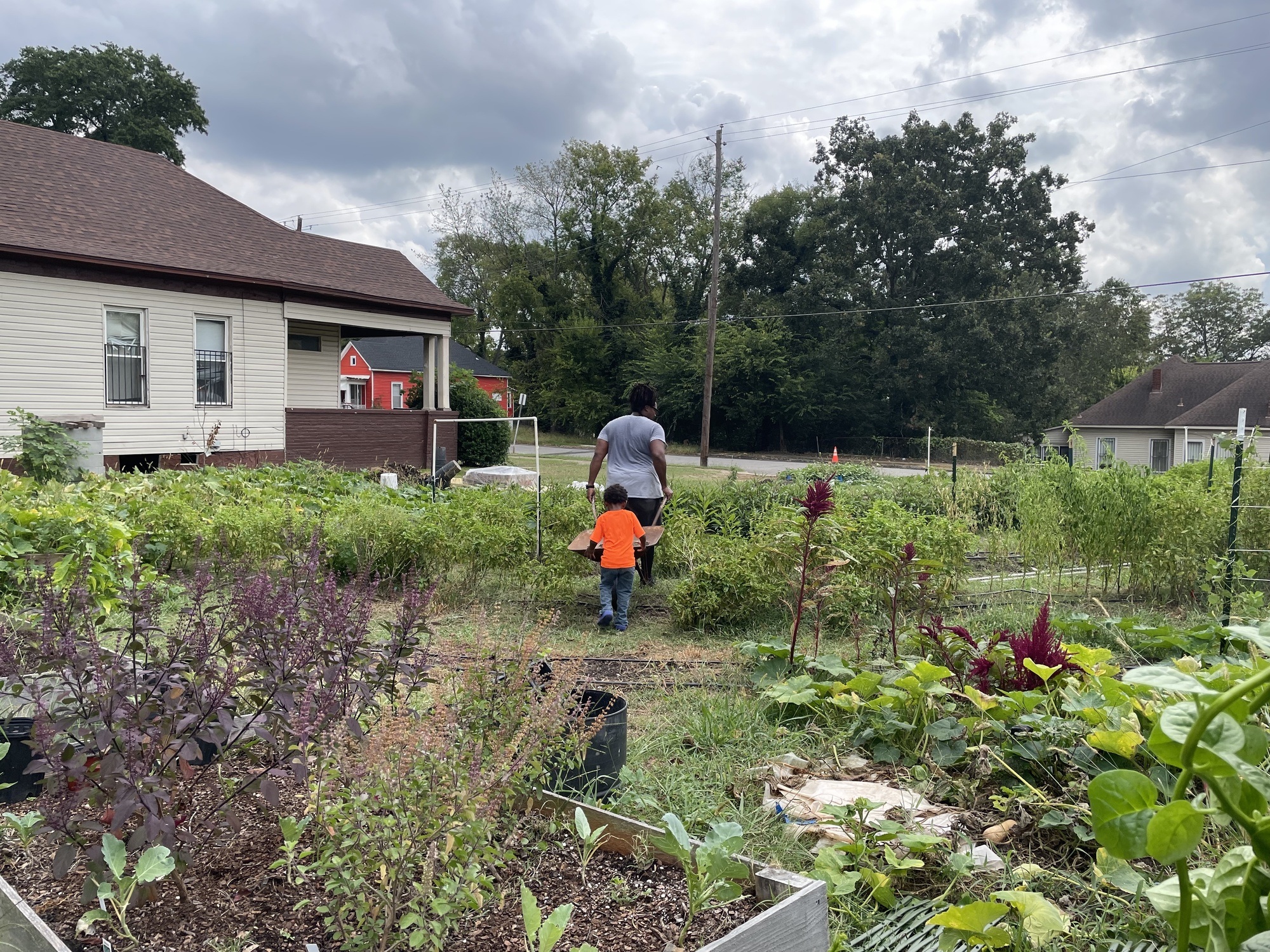
Aquaponics requires managing different types of cultivation, supplementing skills in traditional soil-based agriculture with knowledge of growing fish and produce in water or other materials.
Safiya Charles
Growers must also grasp both aquaculture and agriculture, essentially managing two types of cultivation at once. Despite these hurdles, some urban farmers believe the effort is worth the possibility of community improvement and economic impact.
Yemi Amu is the founder and director of Oko Urban Farms in Brooklyn, New York. The Nigeria native has been working with aquaponics for a decade, setting up her first farm—and New York City’s first outdoor aquatic farm—in an abandoned lot through a municipal program in 2013. She expanded to a second independently acquired site this year, featuring three deep-water beds with plants floating on top in a raft system. In another section, she grows herbs and root crops in soilless mediums—things like sand, Perlite, peat moss, and coconut husks—irrigated by four 700-gallon tanks filled with carp, goldfish, and koi.
Amu plants common vegetables—onions, tomatoes, sweet potatoes—and vegetables that feature prominently in immigrant cultures and cuisines, such as Scotch bonnet peppers, lemongrass, and okra. She also added plants that inspire people to think of agriculture beyond food, like indigo for plant dyes.
“Aquaponics gives me an opportunity to center water in conversations about food. It’s an opportunity to talk about places around the world suffering from drought, connections between the marine world and us. How much water do we use for agriculture, for fashion? What does it look like to feed people when there is no water left?” said Amu.
“The idea that you could farm fish in a way where you’re not only saving water, you’re saving money, for people who pay for water, and you can not only raise your own fish but also have vegetables that you can also raise and sell, to me, was like—Why wouldn’t anyone do this?”
Her motivation to start farming sprang from a former job as a chef and nutrition educator for a New York nonprofit that provided people with permanent housing. The group hired Amu to cook healthy meals for residents five days a week and to teach them about nutrition. As part of her work, she often took groups to farmers markets and grocery stores, but found that while residents followed healthier eating practices when she was present, those behaviors would lapse when she was absent. Frustrated, she and her coworkers decided to start a garden on the roof of their building in 2009 so that residents could get hands-on and see for themselves the benefit of growing healthy food.
Two years later, while working in the rooftop garden, a community volunteer introduced her to aquaponics. It was a concept Amu was familiar with, but didn’t know by name.
“When I was in Nigeria, my neighbor raised catfish in her backyard but couldn’t keep the business going because of the amount of water it required and the cost. So the idea that you could farm fish in a way where you’re not only saving water, you’re saving money, for people who pay for water, and you can not only raise your own fish but also have vegetables that you can also raise and sell, to me, was like—Why wouldn’t anyone do this?” she said.
Her interest took her across the country in 2011—to Florida, Minnesota, and Wisconsin—in search of experienced aquaponics farmers from whom she could learn. Relying on relationships with educational institutions like New York University’s Animal Behavioral Studies program, as well as experienced farmers, has helped to sustain her operations.
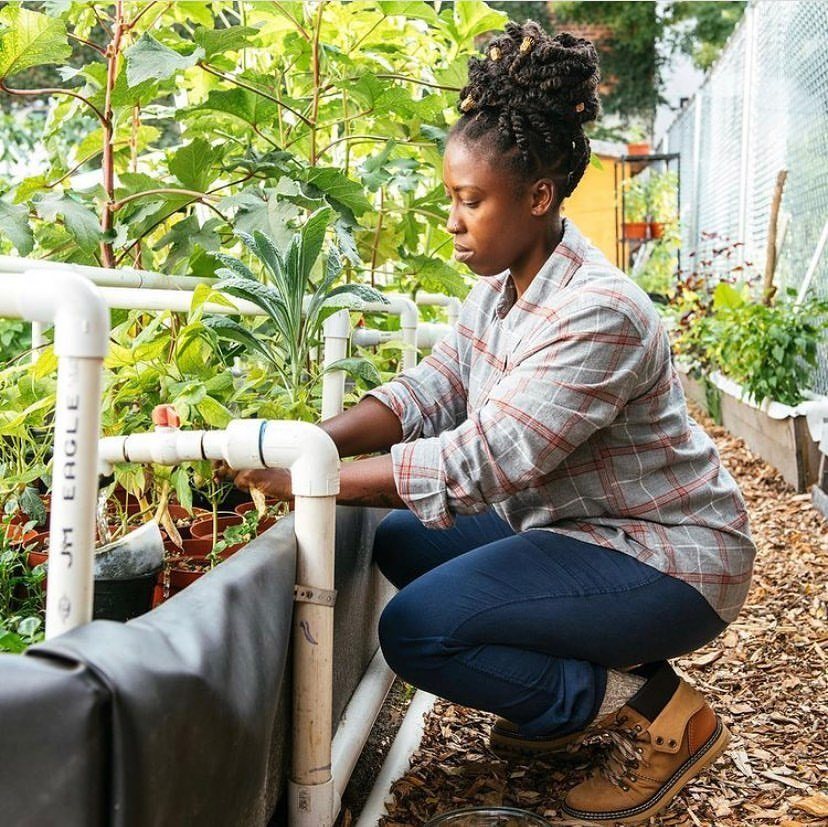
Yemi Amu is the founder of Oko Farms, an aquaponic farm and education company in Brooklyn, New York.
“I have a farmer upstate in Westchester that I call all the time. He does not, for the life of him, understand what I’m doing here. He’s like, ‘You have fish—in Brooklyn?’ But I pester him with questions when I don’t know what’s going on with my fish. Establishing a relationship with someone who has more knowledge and experience when it comes to fish is important,” she said.
While aquaponics garners much attention for its uniqueness, Amu said it shouldn’t be romanticized or mistaken for ease. The rewards and challenges go hand in hand. People stop her on the street to tell her they used herbs she’s grown to make traditional medicine. When her fish are ill, she must painstakingly attempt to identify what the cause is and how to fix it. Ultimately, she believes aquaponics goes beyond simply feeding people; it has implications for building a more sustainable world.
“I very much believe in urban farming not as a means to feed people but as a means to create awareness and policy around how to create a better food system, and how to create a more climate-friendly world,” said Amu. “We’re creating and maintaining ecosystems in an environment that’s surrounded by concrete. That aspect of it is rewarding because people get to see this, and urban planners come and politicians come. I’m hoping that this changes what our city looks like and what cities look like around the world.”
A little more than an hour away from Villanueva and Gooden’s Birmingham farm, Darryl Parker and his brothers in an graduate chapter of Omega Psi Phi fraternity view aquaponics as a way to provide healthy, affordable food for their neighbors. The fraternity owns close to 2 acres of land on a portion of South Court Street. There, shuttered businesses and boarded-up homes sit minutes away from Old Cloverdale, one of Montgomery’s most affluent neighborhoods. Corner convenience and discount stores located in the predominantly Black neighborhood sell low-cost groceries and canned goods, so the fraternity plans to establish two greenhouses utilizing aquaponics to supply the neighborhood with fresh produce and a local source of protein.
“Is this going to be some large commercial operation? No. It’s going to be very small-scale. But even that can make a dent in the local community, that the folks can walk to a place where they can get greens and fish.”
“Is this going to be some large commercial operation? No. It’s going to be very small-scale. But even that can make a dent in the local community, that the folks can walk to a place where they can get greens and fish,” said Parker, who works as the Montgomery County election director.
Through philanthropic work in the city, the Ques (members of Omega Psi Phi) have developed a trusted reputation for community service. At one Thanksgiving turkey drive, Parker surveyed a group of mothers, asking if they would shop at a neighborhood grocery if they could get produce at heavily discounted prices. They indicated overwhelming support. For Parker—whose grandparents farmed in Greene County, and who grew up backyard gardening in Chicago—it was important that the fraternity do something with a lasting impact, unlike the faded signs of the empty strip mall that faces the fraternity’s property.
Parker began researching aquaponics some years ago as a hobby interest. Much like Davis, he was struck by the novel nature of the method and convinced his 75 fraternity brothers in Montgomery’s chapter to get behind the idea of building an aquaponics setup. After visiting with Auburn’s extension agents, Parker said the group is putting together final plans to efficiently utilize their land and erect two greenhouses—the first in late winter 2022 and the second in late summer or early fall.
The group plans to fund the operation through grants, though the fraternity chapter has long-term aspirations of establishing a local full-service grocer in the area.
“What I foresee for us is showing our fraternity members across the world this is something we can spearhead that’s sustainable,” said Parker. “Ain’t no reason that people should be starving in this country when we can do something about it. We have the requisite education, the knowledge, and the resources,” said Parker. “We’ve gotta do something more entrenched, more intrinsic, and long-term. This has got to be something generational.”
